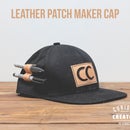Introduction: Perfect Bound Paperback Notebook
THIS PROJECT IS ENTERED INTO THE 'PAPER' CONTEST. IF YOU ENJOYED IT PLEASE CONSIDERING GIVING ME A VOTE! JUST CLICK 'VOTE' ABOVE ↑
In this Instructables, I show how to make a perfect bound notebook. I wanted a small paperback notebook and using my bookbinding press, I used an old classic car manual as a custom DIY notebook cover and the perfect binding method using PVA Glue for the spine of the book.
For this project you will need;
Step 1: Paper Block
I started with some standard copier or printer paper. I didn't want this notebook to be too big and decided that A5 would be perfect for me. I never wanted to carry around in my pocket (in which case I would make it A6 or similar), but instead, it would live in my backpack which comes everywhere with me anyway.
My first thought was, why by A5 paper when you can just cut it down using a paper guillotine. I tried this. And failed. None of the paper lined up nicely, it just didn't work out well for me. If you have a better guillotine than me it might be fine!
So I hunted around and ordered some A5 copier paper from Amazon. At some point, I really want to make my own paper, but for this project, I wanted to keep it simple. I got out about 50 sheets of paper. I found this gave a good thickness of the book, without being over thick. If this was to live on a desk or something I would probably go much thicker, but as I carry it around didn't want it too thick! I tamped the pieces down on all sides to make sure the block was perfectly even. And use some binding clips to temporarily hold it together.
Step 2: Bind + Glue
Next up I put the block of paper in my binding press with the clips still attached. If you want to make your own bookbinding press, I have a full Instructables about it here. Once the block was in, I tightened all the screws so the book was held firmly and removed the clips.
I took some PVA glue and a hard bristle paintbrush and painted a thin layer of PVA glue down the spine. I did a very fine, but made sure it was even and the whole thing was coated. I let this dry for around 20mins and recoated, I think I did 4 layers in total. I made sure between layers to run my fingers down the edges to make sure excess glue didn't run down the sides of the paper.
Step 3: Cover Up
I had an old classic car manual from one of my dad's old cars (he has quite a few of these don't worry!) I leafed through until I found I page I liked with some interesting drawings on. I think it's a break down of how the radiator works? Either way, it looks cool.
I wanted to use black card as it would blend in with the gilding I would do later, so I took a sheet of A4 card and sprayed some spray glue on it. The first version I tried (and many tutorials say) use more PVA glue here. But I found that no matter how thin I spread the glue, it made the cover sheet go all wrinkly, or didn't glue it down at all. In the end I decided to use some spray glue, this worked so much better and didn't effect the cover paper at all!
Step 4: Gilding
I wanted this book to stand out a little, so I watched a few videos on 'gilding', the edges of the book. Traditionally this is gold but I wanted to add a bit of a modern twist so decided to go with black. I used some black acrylic paint and brushed it on in very thin coats again. Basically the whole process of making this book you are trying to avoid damaging the paper of the book itself. If you are too heavy handed with the glue or the paint you will end up damaging the paper!
I made sure to put the paper block back into the press to hold all the pages together and stop any paint running down onto the pages. I went around all 3 sides and added paint to them.
Once that paint was dry it was time to get the final assembly done. I laid the block of paper onto the inside of the cover and folded the cover around the spine. You can measure it out, the width and thickness of your book and transfer those across, you would get a slightly better fold. But in the end, I just decided to go the straightforward route and fold the cover around the block.
Take some more spray glue, I coated the inside of the cover and glued the paper inside the cover.
Step 5: Final Images
That's it. I think it's cool you can make these look however you want. I'm excited to learn the different types of bookbinding. This one looked quite easy to start with, and what I like about perfect binding is how easy it is to take pages out. This paperback notebook is for jotting down ideas, and sometimes I go off an idea and can just take the page out!
If you make your own make sure to come back here and share a photo with me!
THIS PROJECT IS ENTERED INTO THE 'PAPER' CONTEST. IF YOU ENJOYED IT PLEASE CONSIDERING GIVING ME A VOTE! JUST CLICK 'VOTE' ABOVE ↑

Runner Up in the
Paper Contest 2018













